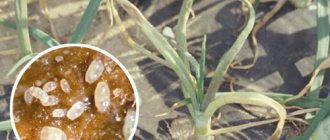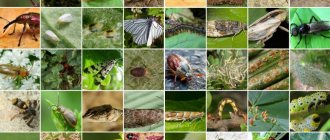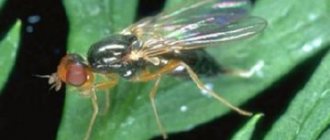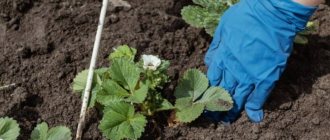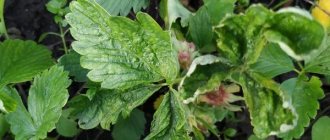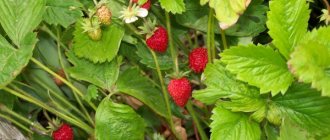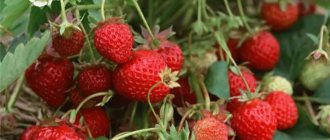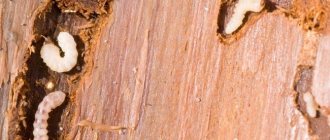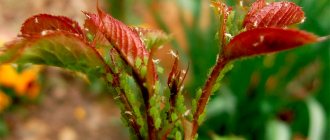In order to competently deal with pests of garden strawberries (strawberries), you need to learn more about their lifestyle and “preferences”. Only in this case the chosen control measures will be effective.
Garden strawberries are considered a rather delicate crop and susceptible to attack by pests. Even timely care and treatment of plants from diseases and insects will not fully guarantee that you will receive a generous harvest. Warm weather, an abundance of greenery and fruits attract not only “strawberry saboteurs”, but also insects of other species that are not averse to feasting on young leaves and sweet berries. Read about the most dangerous of them in our article.
Strawberry whitefly, or strawberry whitefly (Aleurodes fragariae)
This small insect is one of the most dangerous strawberry pests. The length of the whitefly does not exceed 1.5 mm, and this butterfly can be “identified” by its snow-white wings, as if covered with a waxy coating. It is difficult to detect whiteflies in an area not only because of their microscopic size, but also because their colonies populate the lower surface of leaves and avoid sunlight. Therefore, first of all, pests should be looked for in shaded areas and in dense plantings.
With a greater degree of probability, only adult insects can be detected, because the eggs and flat six-legged larvae are so small and translucent that they cannot be seen even upon close examination. Insects feed on the juice of fresh leaves and overwinter in plant debris and upper layers of soil. They can also be detected by traces - the remains of vital activity in the form of resin or plaque.
Measures to combat strawberry whitefly:
|
Rust resistant varieties
Planting strawberry varieties resistant to fungal diseases allows you to reduce the pesticide load to zero and obtain an environmentally friendly harvest.
- Bereginya. Among the domestic breeding developments, the variety is the most highly resistant to fungal diseases. In addition to rust, it successfully resists such a dangerous disease as verticillium wilt. Initially zoned in the Central Federal District. Gradually spread throughout Russia, from the Krasnodar Territory to the Bryansk Region. There is information about the successful cultivation of Beregini in the Urals and Siberia. Flowering and ripening late. To obtain almost absolute protection against fungal infections, it is necessary to make sparse plantings that provide good ventilation.
- Dewdrop. The variety is recommended for cultivation in the Central region. It has a very early ripening period and has a universal purpose of use. The variety is famous for its excellent taste characteristics. Tasters rate them a solid “A”. The average yield according to the results of state variety trials was 52 c/ha. Excellent taste, high yield and disease resistance make Rosinka one of the most outstanding varieties on the berry crops market.
- Crimean early. A variety of Ukrainian selection, excellent in yield and many other characteristics, which is recommended to be grown under film. In closed ground, humidity is increased and conditions are favorable for the proliferation of pathogenic spores, the more valuable is its ability to resist fungus. Ripens very early - by the end of May. In greenhouses - another month earlier. The average yield is impressive - about 110 c/ha. Tolerates heat and sudden spring cold snaps well.
- Elsinore. Despite the fact that the Italian variety is intended for a mild Mediterranean climate, it has taken root in many Russian regions. Gardeners are attracted by a stable, impressive harvest and sweet berries that they can be proud of. Get up to 1.0 kg with good care. from the bush - this is not the limit. Remontant Elsinore strawberries begin to ripen in early June, along with early varieties. The berries are distinguished by moderate sweetness and juiciness. Potassium phosphate and magnesium fertilizers improve the quality and taste of fruits.
- Tsarskoselskaya. Large-fruited, high-yielding strawberries are ideal for growing in the North-West region. It is characterized by winter hardiness and unpretentiousness to soil and climatic conditions. Resistant to stress. In commercial plantations, it complements the assortment of late varieties. The taste of the berry is sweet and sour, with a pronounced strawberry aroma. In terms of productivity, it is classified as a medium variety, inferior to new products of the intensive type. However, its resistance to fungal attack and Verticillium wilt is superior to many crops.
Farmers and gardeners have to choose. You can choose an overseas variety, beautiful and large, with a high declared yield, but not winter-hardy and not resistant to disease. Or choose local seedlings, zoned to soil and climatic conditions, less susceptible to fungi, not always high-yielding and not so large-fruited.
Strawberry mite (Tarsonemus fragariae)
These small insects cause a lot of trouble in spring and summer. And if ixodid ticks are carriers of dangerous diseases, then garden pests completely destroy plantings. In the process of development, the elusive mites acquired microscopic sizes (no more than 0.2 mm) and an inconspicuous color, which varies from translucent to yellow-brown.
It is very difficult to detect pests at the initial stage. Typically, the impact of mites can be noticed only in the second half of summer, when the leaves curl, acquire a yellowish waxy coating, wrinkle and die. The bushes become dwarf and lifeless, as mites literally suck all the juices out of the plant. Although ticks live everywhere and in regions with any climate, humid and warm zones in the north are more attractive to them than the arid and hot south. Average yield losses depending on the variety are 20-50%.
Measures to combat strawberry mites:
|
Verticella wilt
In this case, the affected plants take on a flattened appearance, become smaller, and the leaves become yellowish in color. Dark brown spots or stripes form on the shoots, in the rotting rosette, and even on the roots. Throughout the entire period of plant development, the symptoms of this disease can manifest themselves in different ways. Most often, plant wilting occurs during the filling and ripening of berries. In the absence of proper care of the plantings, only one week may pass from the moment the first signs of the disease appear to the complete death of the plant. It is recommended to maintain a sufficient level of potassium phosphate fertilizers in the area with strawberries and use products such as Trichodermin and Guabsin for processing. If used in combination, this will improve the quality of processing by 92%. High agricultural technology and selection of healthy planting material will help increase the resistance of strawberries to this disease.
Strawberry leaf beetle (Galerucella tenella)
Small brown bugs (3-4 mm) settle on the back side of the leaves and actively begin to make passages in them, gnawing out the pulp and core. They can form small colonies or settle on leaves alone. The female lays eggs on the underside of leaves or on the petiole. The larvae (yellow with a brown head) appear within two weeks and begin to eat the leaves.
If there are a lot of leaf beetles, the strawberry bushes quickly wither, the leaves dry out, and fruiting stops. The beetles gnaw out the pulp of the leaves, leaving the film with which they are covered intact. By autumn it becomes thinner, and it becomes noticeable that through holes are made in the strawberry leaves.
Measures to combat strawberry leaf beetle:
|
Ants
Ants love to settle in high beds. It is not easy to fight them, especially under mulching agrofibre. Ants make heaps at the base of the bushes, nibbling on ripe berries. There are many folk methods of getting rid of this scourge, but the most effective are chemical baits (Grom-2 and its analogues). If the ants do not cause much damage, it is better not to touch them, because they destroy many garden pests (slugs, larvae).
Strawberry nematode (Aphelenchoides Fragariae)
Nematodes are incredibly voracious and tenacious worms that feed on all vegetable and berry crops. Detecting a roundworm up to 1 mm long is not easy. Especially considering that it prefers to settle in the buds and axils of leaves. However, the nematode can hide in the soil for a long time and successfully withstand both adverse weather conditions and various chemicals.
Nematodes cause deformation and rotting of buds, ovaries and flowers. They curl and wither, the bushes stop growing, become dwarf and sometimes may not produce berries at all. The leaf petioles turn red, lose their pubescence and become thinner. The leaf blades darken and feel like leather to the touch. It is believed that the Festivalnaya variety is relatively resistant to nematodes, and strawberry bushes of varieties such as Krasavitsa Zagorya and Rannyaya Makheraukha can lose up to 75% of the harvest.
Measures to combat strawberry nematode:
|
Stress is the main cause of disease
Stress is nothing more than an abiotic and biotic environmental factor that limits the life processes of the body. The changes in body function that occur in response to a stressor depend on the duration and intensity of the exposure.
Stress factors are divided into abiotic and biotic
| Biotic | Abiotic |
|
|
As a result of the occurrence of a stress factor in a plant, 4 phases of reaction can be distinguished:
- The anxiety phase or decreased immunity is the first reaction to a stress factor.
- Recovery phase or elimination of damage (then an increase in resistance occurs).
- Acclimatization – high resistance and physiological response.
- Exhaustion is a decrease in immunity due to too long a stress factor.
In bad years, both groups of stress factors arise – biotic and abiotic. What’s even worse is that stress factors overlap many times over, resulting in plants weakening and significantly slowing down the activation of immune mechanisms. To maintain plant health, you will have to deal with unfavorable factors.
Raspberry weevil (Anthonomus rubi)
If this pest appears on your site, then you should know that the threat of destruction hangs not only over strawberries, but also over raspberries and blackberries. Adult beetles are small (up to 2-3 mm in length) gray, dark or black. They cause the greatest damage to young leaves, buds and pedicels, and especially to early varieties of strawberries.
As a rule, a small number of berries, caused by the fact that the weevil has damaged the pedicels of the first buds, is mistaken by gardeners for a “crop failure.” After this, the females lay eggs in the buds, from which larvae hatch, devour the contents of the buds and pupate in them. After three weeks, their pupae emerge as adults and eat the leaves. They can be detected by long narrow passages in the leaves, and you can also see crawling insects.
Measures to combat the raspberry-strawberry weevil:
|
Who gnaws strawberry leaves and why are they in holes, what to do and how to fight?
Strawberries or garden strawberries are one of the most awaited berries in the garden. It is not surprising that not only people are not averse to eating juicy strawberries. There is no end to those interested, everyone is trying to grab their share of the harvest. You have to fight birds, rodents, insects. In the struggle for tasty berries, it is important for the gardener not to lose sight of the condition of the plants themselves, which can destroy diseases and pests with gusto. In this case, we will talk about such unpleasant signs of damage to berry plants, such as holes in strawberry leaves.
Slugs (Arion lusitanicus)
If these leisurely creatures look into your area, rest assured that they will not crawl past the strawberries. Slugs are especially active during periods of prolonged rain and at air temperatures of 15-17°C. If strawberries grow in the shade, or the plantings are dense, there is no need for better conditions for the appearance of slugs. Their length can reach 50 mm, and their color varies from light yellow to almost black.
Slug eggs are laid in damp clods of earth. The adult pest primarily feeds on berries that lie on the ground or hang down to it. They often also crawl onto the leaves and gnaw out rounded holes in the center, with the slug’s peak activity reaching its peak at dusk. They are true long-livers of the garden world; some individuals can live up to 4 years.
Measures to combat slugs:
|
Not only people, but also numerous insects love to eat the sweet berry in the summer. First of all, pests are attracted to unkempt areas, where we ourselves unintentionally create suitable conditions for their existence. Therefore, keep the strawberry beds clean, do not thicken the plantings and regularly carry out the necessary agrotechnical measures. And then the “enemies” will avoid your strawberries.
Prevention of pests on strawberries
Garden strawberries are a capricious crop that requires careful, competent care. Experienced summer residents begin cultivating the beds in the spring, managing to spray the plantings before flowering and protect them from insect attacks. Standard treatment scheme:
- in spring, before the stage of bud formation and strawberry flowering;
- in the fall, when the berries are picked, the bushes are trimmed and plant debris is removed.
To repel and protect against insects in the spring, tobacco, marigolds, and calendula are planted next to strawberry beds. To disinfect the soil and spray bushes, more gentle biological preparations are used, as well as infusions and decoctions of herbs according to folk recipes.
Means of preventive treatment:
- ammonia solution (40 ml per bucket);
- solutions of copper or iron sulfate;
- iodine composition (dilute 10 drops in a liter of milk, pour the mixture into a ten-liter bucket of water, stir);
- boric acid solution (1 gram of powder is diluted in 10 liters of water).
On a note! Treatment with iodine is not only protection against insects and diseases (gray rot), but also an excellent fertilizer for the berry garden.
Autumn preventive measures include:
- garbage collection;
- pruning bushes (leaves, mustaches);
- fertilizing with potassium fertilizers (without chlorine!);
- treating the plantation with a solution (soap, vinegar, ash - 2 tablespoons each, vegetable oil - 3 tablespoons diluted in a bucket of warm water).
These measures will protect against the appearance of aphids, weevils, and mites on strawberries, and will save you from labor-intensive work in the summer season.
Birds
The gardener's feathered helpers also pose a particular threat to already ripe strawberries. It happens that they fly in whole flocks to strawberry beds and in a few minutes destroy a huge part of the crop. There are two good and time-tested ways to protect berries from bird invasion. Metal pegs are driven in around the strawberry bed and a fine mesh is placed over them. Through it, birds will not be able to damage the berries in any way. If there is no net, you can scare away the birds. To do this, New Year's tinsel and computer disks are hung next to the beds. During even a slight breeze they begin to sway and sparkle. This will scare away annoying birds. Note that these two methods can be used to protect berries not only on strawberry plantings, but also on other berry fields.
We can conclude that strawberry pests can be controlled only through prevention. Then you will not need to buy and use chemicals on the site. It is also important to observe cultural rotation. Do not grow strawberries in one bed for more than four years. And then don't put her there again. The earth should be allowed to rest for three to four years. During this time, many strawberry pests will disappear from there.
Bronzovka shaggy
Also called Olenka Mohnataya. It is a black beetle, 13 millimeters in size. Its body is covered with pale spots and multiple hairs. This pest most often lays its eggs in soil enriched with humus. The larvae initially feed on humus and eat a huge amount of plant roots. Already adult individuals damage not only the leaf apparatus of the bushes, but the roots and inflorescences.
It is necessary to treat plantings against hairy bronze beetles before flowering. We advise you not to use Karbofos and potent drugs, as they disintegrate only within 30 days. To treat plantations against hairy bronze blight, it is recommended to use products that are less harmful to humans. For example, Calypso or Fitoverm.
In the old days, our ancestors could protect and save strawberries using another effective method of combating this insect. They burned straw or dry leaves next to the strawberry beds. This method drives the pest away from the plantings. In addition, since the hairy bronze lives in the ground, digging up the soil also gives a good effect. This should be done in early spring. During digging, insects are removed from the soil and then destroyed.
Preventive methods to protect the garden
Experienced gardeners and gardeners recommend processing strawberries in a timely manner and preventing pests from appearing on them. Preventive measures consist of agrotechnical measures, the use of folk remedies and chemicals.
Agrotechnical measures
Proper preparation of the land for the growing season and winter will prevent pests from appearing on strawberry bushes. Agrotechnical measures are labor-intensive, but do not require financial investments, do not harm human health, and help increase crop yields. The main ways to prevent the appearance of parasites:
- using only high-quality seeds, observing crop rotation;
- destruction of weeds in the beds;
- regular weeding of beds, digging and clearing the soil of wintering larvae;
- compliance with the irrigation regime, absence of humidity and excessive thickening of the beds;
- cultivation of entomophages (Gall midge aphidimisa, Phytoseiulus) that eat pests.
When planting strawberries, gardeners place the crop next to plants whose smell repels pests. Near the beds they make a flowerbed of marigolds, tobacco, calendula, and tansy.
Pesticide
Chemical preparations allow you to cover a large area and get rid of pests at all stages of growth (eggs, larvae, adults). Toxins will also help quickly deal with large colonies of insects. But it is recommended to use the products in the spring, before the start of the growing season. The best remedies that fight all parasites that infect strawberries:
- Spark;
- Inta-CM;
- Apollo;
- Hall;
- Karate;
- Shar Pei;
- Nurel-D.
The drugs are sprayed onto the bushes, quickly absorbed into the foliage and have a contact-intestinal effect on the parasite. Having tried the treated plant, the insect cannot move and eat, which leads to its death in 3-4 days.
If aphids, bugs, or whiteflies appear in the garden beds during flowering or berry growth, it is recommended to use biological products. “Aktara” and “Karbofos” are considered the best insecticides. The products are used no later than two weeks before harvest.
